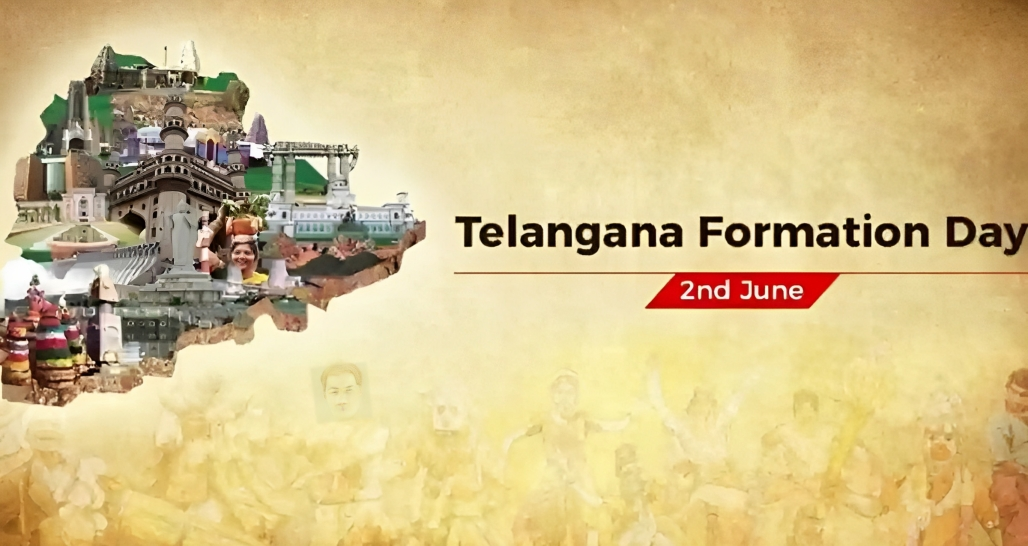
Copyright infringement not intended
Context: Telangana Statehood Day is celebrated on June 2 every year to mark the formation of the state of Telangana in 2014.
Details
- Telangana Statehood Day is an occasion to celebrate the achievements and aspirations of the people of Telangana. It is also an opportunity to remember the sacrifices and struggles of those who fought for their rights and dignity.
- Telangana is the youngest state in India, carved out of the erstwhile Andhra Pradesh after a long and complex political struggle.
- The demand for a separate Telangana state was driven by the sentiment that the region had been neglected and exploited by the dominant Andhra region in terms of development, representation, and resources.
Background
- The history of Telangana can be traced back to the princely state of Hyderabad, which was ruled by the Nizam of Hyderabad until 1948. The state comprised three linguistic regions:
- Telugu-speaking Telangana
- Marathi-speaking Marathwada
- Kannada-speaking Karnataka
- After India's independence in 1947, the Nizam refused to join the Indian Union and tried to maintain his sovereignty with the help of a militia called the Razakars.
- The Indian government launched a military operation called Operation Polo in September 1948 and annexed Hyderabad state.
States Reorganization Commission (SRC)
- In 1953, the States Reorganization Commission (SRC) was set up to reorganize the Indian states on linguistic lines. The SRC recommended that Telangana be kept as a separate state, as it had a distinct cultural and historical identity from Andhra.
- However, under pressure from Andhra leaders, Telangana was merged with Andhra state to form Andhra Pradesh in 1956. A gentleman's agreement was signed between the two regions to ensure fair distribution of power and resources.
1969 agitation
- The gentleman's agreement was soon violated by the Andhra leaders, who dominated the politics and administration of the United state. Telangana leaders felt that their region was being discriminated against in matters of education, employment, irrigation, and development.
- In 1969, a massive agitation was started in Telangana, demanding a separate state. The movement was met with repression by the central and state governments, resulting in hundreds of deaths.
Six-point formula
- The movement subsided after a six-point formula was devised by the central government to address the grievances of Telangana. However, the formula was not implemented effectively and Telangana continued to lag behind Andhra in various indicators.
- In 2001, a new political party called the Telangana Rashtra Samithi (TRS) was formed by K. Chandrashekar Rao (KCR), who revived the demand for statehood. The TRS allied with various national and regional parties at different times to gain support for its cause.
2009 hunger strike
- In 2009, KCR went on an indefinite hunger strike, which sparked a massive wave of protests and agitations across Telangana. The central government announced in December 2009, that it would initiate the process of forming a separate Telangana state. However, this decision was met with opposition from Andhra leaders and parties, who launched counter-protests and demanded a united Andhra Pradesh.
- The central government then put the decision on hold and appointed a committee headed by Justice B.N. Srikrishna to look into the issue.
Srikrishna committee
- The Srikrishna committee submitted its report in 2010, which gave six possible options for resolving the issue, ranging from maintaining the status quo to bifurcating Andhra Pradesh into two states.
- The committee did not recommend any particular option but suggested that bifurcation with Hyderabad as a union territory would be the most workable solution. However, this option was rejected by both Telangana and Andhra parties.
Creation of Telangana
- In 2013, the Congress-led UPA government decided to bifurcate Andhra Pradesh and create a separate Telangana state with Hyderabad as its capital.
- The Andhra Pradesh Reorganization Act was passed by both houses of Parliament in February 2014 amid protests and chaos.
- On June 2, 2014, Telangana became the 29th state of India.

Constitutional provision to create a new state
- The Constitution of India provides for the creation of new states and union territories in India.
- According to Article 2, the Parliament of India can admit or establish new states into the Indian Union on such terms and conditions as it may deem fit.
- Article 3 of the Indian Constitution empowers the Parliament to create new states or alter the existing ones by changing their names, boundaries or areas. This article reflects the federal nature of the Indian polity, which allows for the accommodation of diverse linguistic, cultural and regional aspirations of the people.
Procedural under Article 3
- Article 3 also lays down certain procedural safeguards to protect the interests of the affected states. Before introducing a bill for any of the above purposes, the President has to refer it to the concerned state legislature for expressing its views within a specified period.
- The views of the state legislature are not binding on the Parliament, but they have to be taken into consideration by it. The President can also extend the period for giving views by the state legislature.
Constitutional amendment not required
- Article 3 also clarifies that such a law does not require a constitutional amendment under Article 368. It can be passed by a simple majority of both Houses of Parliament.
- However, such a law also has to provide for the amendment of the First Schedule and the Fourth Schedule of the Constitution, which contain the list of states and union territories and their representation in the Rajya Sabha respectively.
Article 3 has been invoked several times since independence to reorganize the states on linguistic, administrative or political grounds. Some examples are:
- The States Reorganisation Act 1956, created 14 states and 6 union territories based on linguistic criteria.
- The Bombay Reorganisation Act 1960, bifurcated Bombay into Gujarat and Maharashtra.
- The Punjab Reorganisation Act 1966, divided Punjab into Punjab and Haryana and transferred some areas to Himachal Pradesh.
- The State of Himachal Pradesh Act 1970, conferred full statehood on Himachal Pradesh.
- The North-Eastern Areas (Reorganisation) Act 1971, which created Meghalaya, Manipur and Tripura as full-fledged states.
- The State of Mizoram Act 1986, granted statehood to Mizoram.
- The State of Arunachal Pradesh Act 1986, conferred statehood on Arunachal Pradesh.
- The Goa, Daman and Diu Reorganisation Act 1987 separated Goa from Daman and Diu and made it a state.
- The State of Chhattisgarh Act 2000, carved out Chhattisgarh from Madhya Pradesh.
- The State of Uttarakhand Act 2000, which created Uttarakhand from Uttar Pradesh.
- The State of Jharkhand Act 2000, which formed Jharkhand from Bihar.
- The Andhra Pradesh Reorganisation Act 2014, divided Andhra Pradesh into Telangana and Andhra Pradesh.
Article 3 is an important provision that enables the Parliament to respond to the changing needs and demands of the nation. It also reflects the flexibility and dynamism of the Indian Constitution.
The creation of new states and union territories in India is a complex and sensitive issue that involves various political, social, economic and cultural factors. Some of the reasons for demanding new states are:
- To protect and promote the interests of a distinct linguistic, ethnic or regional group.
- To ensure better administration and development of a backward or neglected region.
- To address the grievances and aspirations of a marginalized or oppressed section of society.
- To reduce the size and population of a large or overburdened state.
- To enhance the representation and participation of a region in national affairs.
There are also some challenges and drawbacks associated with the creation of new states, such as:
- The possibility of disrupting the unity and integrity of the nation.
- The risk of increasing regionalism and separatism among different groups.
- The cost and difficulty of setting up new administrative and judicial infrastructure.
- The loss of revenue and resources for the parent state.
- The impact on inter-state relations and cooperation.
Therefore, the creation of new states and union territories in India requires a careful and balanced approach that takes into account the constitutional provisions, the historical background, the geographical realities, the socio-cultural diversity, the economic viability, the political feasibility and the national interest of the country.

Conclusion
- Creating a new state in India is a complicated and sensitive issue. The Constitution gives the Parliament the power to do so, but also requires respecting the people's wishes and interests, and the nation's unity and integrity. The new state may affect the region and the country positively or negatively. Hence, a thorough and inclusive dialogue is needed before any decision.
Must Read Articles:
Renaming of Places: https://www.iasgyan.in/daily-current-affairs/renaming-of-cities
Creation/Abolition of Districts in India: https://www.iasgyan.in/daily-current-affairs/creationabolition-of-districts-in-india
|
PRACTICE QUESTION
Q. What are the pros and cons of creating a new state in a country? How would such a process affect the political, economic, social and cultural aspects of the existing and new states? What are the main challenges and opportunities that would arise from this decision? How can the stakeholders involved ensure a smooth and peaceful transition to the new statehood?
|
https://indianexpress.com/article/explained/everyday-explainers/telangana-turns-9-history-states-formation-8642693/











